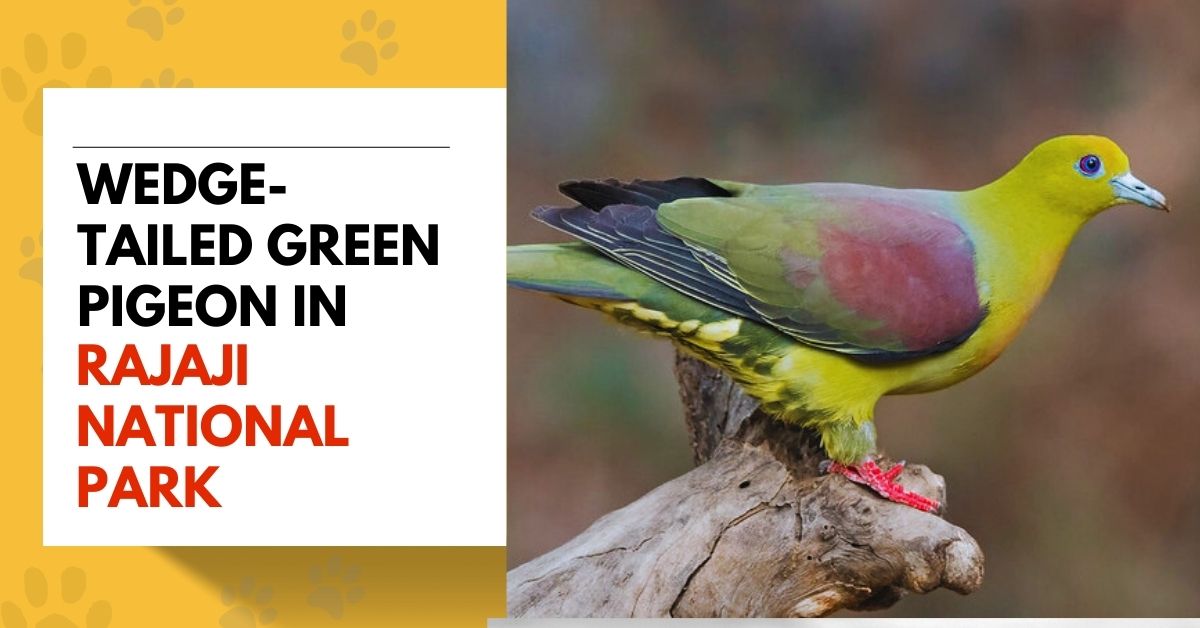Welcome to the Jungle Safari Rajaji National Park blog page. Nestled in the embrace of the Shivalik range in Uttarakhand, India, lies Rajaji National Park, a sanctuary of biodiversity and natural beauty. Among the plethora of avian treasures that adorn this wilderness, one species stands out with its vibrant plumage and graceful presence – the Wedge-tailed green pigeon (Treron sphenurus). Join us on a journey through the verdant landscapes of Rajaji National Park as we unravel the mystique of this captivating bird.
Meet the Wedge-tailed Green-Pigeon


The Wedge-tailed green pigeon, also known as the Green Imperial pigeon, is a species of pigeon belonging to the family Columbidae. Adorned with hues of emerald green, iridescent blues, and subtle hints of yellow, this avian gem exudes elegance and charm. Its distinctive wedge-shaped tail sets it apart from its counterparts, lending it a regal bearing as it glides through the canopy of Rajaji National Park.
A Haven for Avian Diversity
Spread across the undulating terrain of the Shivalik foothills, Rajaji National Park offers a haven for avian enthusiasts and nature lovers alike. With its diverse array of habitats, including dense forests, riverine corridors, and open grasslands, the park provides a rich tapestry of ecosystems teeming with life. Over 315 species of birds call this sanctuary home, including the elusive Wedge-tailed green pigeon.
A Glimpse into the Lifestyle of the Wedge-tailed Green-Pigeon

The Wedge-tailed green pigeon leads a predominantly arboreal lifestyle, preferring the dense foliage of broad-leaved trees for roosting and nesting. Its diet primarily consists of fruits, seeds, and tender foliage, which it plucks with precision using its slender bill. During the breeding season, pairs of Green-Pigeons can be observed engaged in courtship displays, with males showcasing their plumage and vocal prowess to attract mates.
Conservation Challenges and Opportunities
While the Wedge-tailed green pigeon continues to grace the skies of Rajaji National Park, its future faces numerous challenges. Habitat loss, deforestation, and human-wildlife conflict pose significant threats to both the pigeon and its habitat. Conservation efforts within Rajaji and beyond are essential to safeguard the park’s biodiversity and ensure the long-term viability of species like the Wedge-tailed green pigeon.
Ecotourism and Birdwatching-Conservation
Rajaji National Park offers many opportunities for ecotourism and birdwatching, providing visitors with a chance to experience the wonders of nature firsthand. Guided safaris, nature walks, and birdwatching expeditions led by experienced naturalists allow enthusiasts to explore the park’s diverse habitats and observe its rich avian life, including the elegant Wedge-tailed green pigeon.

Community Engagement and Conservation Initiatives
Local communities play a vital role in the conservation of Rajaji National Park and its inhabitants. Collaborative initiatives that involve communities in conservation planning, resource management, and eco-friendly livelihood opportunities can foster a sense of stewardship and ownership over the park’s natural heritage.
Furthermore, research and monitoring programs in partnership with scientific institutions and conservation organizations provide valuable insights into the ecology and behavior of the Wedge-tailed green pigeon and other species within Rajaji National Park. By studying their movements, habitat preferences, and breeding patterns, researchers can develop targeted conservation strategies to mitigate threats and ensure the long-term survival of these populations.

Conclusion
As stewards of Rajaji National Park, we are responsible for safeguarding its biodiversity and protecting the habitats that sustain iconic species like the Wedge-tailed green pigeon. Through collaborative conservation efforts, community engagement, and sustainable tourism practices, we can ensure that this avian gem continues to grace the skies of Rajaji National Park for generations to come.
By celebrating the beauty of biodiversity and embracing our role as custodians of the natural world, we can preserve the legacy of the Wedge-tailed green pigeon and ensure that Rajaji National Park remains a sanctuary of wilderness and wonder for all who visit.
FAQs About the Wedge-tailed green pigeon
1. What is the Wedge-tailed green pigeon, and why is it significant in Rajaji National Park?
The Wedge-tailed green pigeon (Treron sphenurus) is a species of pigeon known for its vibrant plumage and elegant appearance. In Rajaji National Park, it is significant as one of the many avian species contributing to the park’s rich biodiversity and ecological balance.
2. Where is Rajaji National Park located, and why is it popular for birdwatching?
Rajaji National Park is situated in the Indian state of Uttarakhand, encompassing parts of the Shivalik range. It is popular for birdwatching due to its diverse habitats, including dense forests, riverine corridors, and open grasslands, which support a wide variety of bird species, including the Wedge-tailed green pigeon.
3. What is the lifestyle and behavior of the Wedge-tailed green pigeon?
The Wedge-tailed green pigeon leads a predominantly arboreal lifestyle, roosting and nesting in the canopy of broad-leaved trees. Its diet consists mainly of fruits, seeds, and tender foliage. During the breeding season, pairs engage in courtship displays, with males showcasing their plumage and vocalizations to attract mates.
4. What are some threats to the Wedge-tailed green pigeon and the biodiversity of Rajaji National Park?
Threats to the Wedge-tailed green pigeon and Rajaji National Park’s biodiversity include habitat loss, deforestation, human-wildlife conflict, and climate change. Conservation efforts are essential to mitigate these threats and ensure the long-term survival of species like the Wedge-tailed green pigeon.
5. How can visitors contribute to the conservation of Rajaji National Park and its wildlife, including the Wedge-tailed green pigeon?
Visitors can support the conservation of Rajaji National Park by engaging in responsible ecotourism practices, respecting wildlife and their habitats, and adhering to park regulations. Additionally, raising awareness about the importance of biodiversity conservation and supporting local communities through sustainable tourism initiatives can help promote conservation efforts and preserve the park’s natural treasures.

